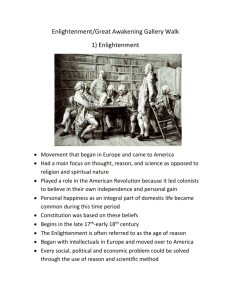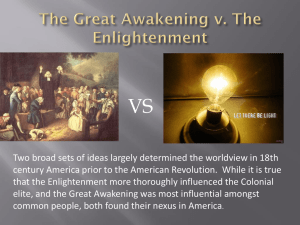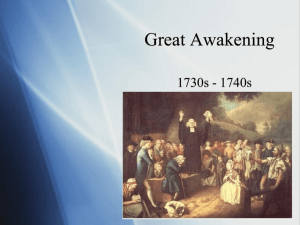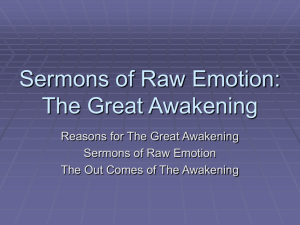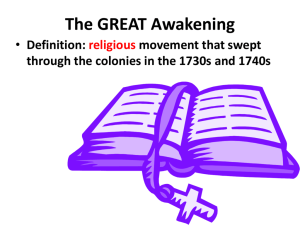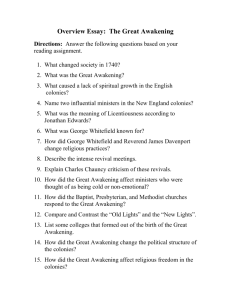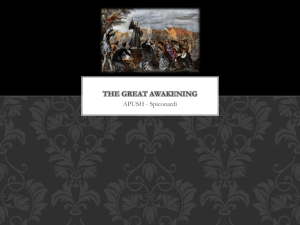Great Awakening - Cloudfront.net
advertisement
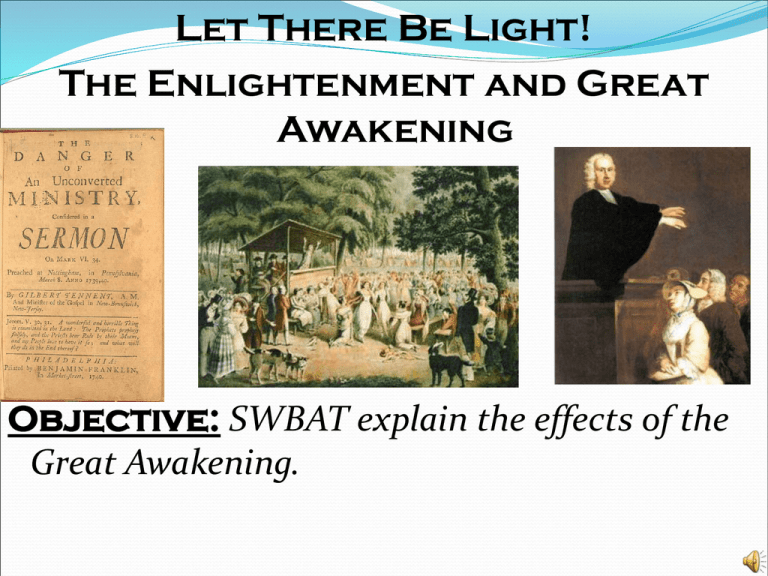
Let There Be Light! The Enlightenment and Great Awakening Objective: SWBAT explain the effects of the Great Awakening. The enlightenment The Enlightenment: challenges predestination; belief in rational thought, In Europe there was a Scientific Revolution and a birth of rational thought called the Enlightenment. John Locke—individuals should be guaranteed the rights to life, liberty, and property; who should make sure they get it? 1) With rational thought in place, what 17th century religious ideas might be challenged? 2) What social class would be able to access Enlightenment thought? The Great Awakening Arminianism: people are rational beings that can shape their destinies; against Predestination. 1. If all you have inherited is a corrupt nature, how can you save yourself from damnation? God = loving; not a hater The Great Awakening Great Awakening: revival of religious fervor; appeals to poor; leads to religious divisions. The Great Awakening burst onto the scene Fiery ministers like Jonathan Edwards Infusion of emotion into religious sermons The movement spread as thousands of people experienced emotional conversions. Colleges like Brown and William and Mary w In 1738, George Whitefield toured America, further fueling the movement. The Great Awakening Great Awakening: relied on strong emotional experiences during worship. 1) Have you ever been in a boring church service? The Great Awakening Effects Great Awakening: divisions in New England; Old Lights v. New Lights. Conflicts developed between Old and New Lights— accused each other of heresy 1) Old Lights prediction? OL condemned emotional enthusiasm and individual relationship with God. Shunned revivalists and the New Lights. NL Challenged the leadership and authority of the Old lights n the church. New Schools, Colleges, Brown and Princeton. The Great Awakening Great Awakening In South: introduction of Christianity to AA population; Baptist and Methodist sects increase. In the South, the Great Awakening introduced Christianity to slaves. Brief period of integration 1) How can you see the Awakening style reflected in many modern African American services? Baptists and Methodists The Enlightenment Challenge The British colonies were more open to intellectual and religious challenges than the French and Spanish. Enlightenment ideas emphasized rationality, harmony, and order. The state existed to provide for happiness and security of individuals who were endowed with rights of life, liberty, and property. Widespread literacy helped spread Enlightenment ideas. Traditional views also had strong popular appeal. Colleges held to a mixture of traditional and enlightened views. A Decline in Religious Devotion The spread of new ideas occurred during a period of religious decline. The Puritan Church experienced falling membership and attendance at services. The change from a congregational to an established church contributed to the Puritan decline. The belief in predestination was weakening as Arminianism became more popular. The Great Awakening In the 1730s, the Great Awakening began with Jonathan Edwards calling for a return to Puritan traditions that appealed to dissatisfied young people. The movement spread as thousands of people experienced emotional conversions. In 1738, George Whitefield toured America, further fueling the movement. Conflicts developed between Old and New Lights. In the South, the Great Awakening introduced Christianity to slaves. The Great Awakening greatly increased church membership, led to the growth of the Methodist and Baptist churches, and paved the way for future political change. George Whitefield, an evangelical preacher from England who toured the colonies in the late 1730s and 1740s, had a powerful impact and helped spark the Great Awakening. SOURCE:John Wollaston,George Whitefield,ca.1742. Baptism by Full Immersion in the Schuylkill River of Pennsylvania, an engraving by Henry Dawkins illustrating events in the history of American Baptists, was published in Philadelphia in 1770. With calls for renewed piety and purity, the Great Awakening reinvigorated American Protestantism. The Baptists preached an egalitarian message, and their congregations in the South often included both white and black Protestants. SOURCE:John Carter Brown Library at Brown University.
